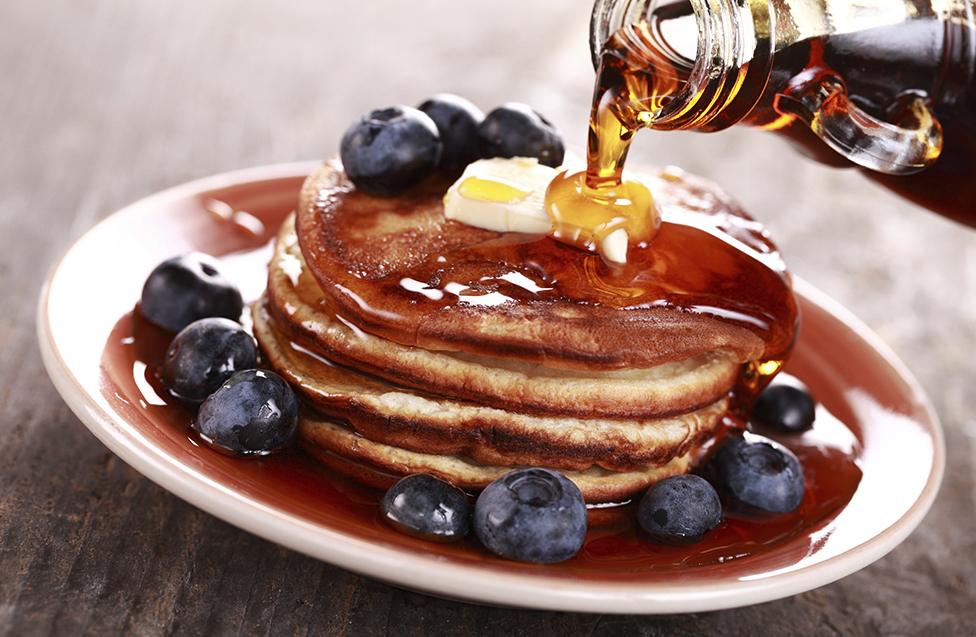'Golden tongue' helps ensure maple syrup quality
- Published

Different grades will find different uses. Not all syrup is suitable for those breakfast pancakes
Scientists have developed a "golden tongue" to help producers test the quality of maple syrup.
A team of researchers from Canada used the precious metal to develop a way of checking whether samples were "off flavour".
The test used nanoparticles of gold, which normally looked red but appeared blue when the sample of syrup was deemed to be below a premium grade.
The details have been l.
Maple syrup is synonymous with the north-eastern reaches of North America.
Its production is one of the oldest agriculture enterprises in the US and Canada, with a history stretching back hundreds of years.
Native Americans first discovered the elixir made from the sap of sugar maples, before passing on the technique to settlers.
Today, the global market for maple syrup is estimated to be in excess of US$1.2bn (拢970m).
Sweet taste of spring
Once the first signs of spring are on the temporal horizon and the sap in the sugar maples (Acer saccharum) begins to rise, farmers set up a network of taps in the trunk of the trees to draw off the sweet produce.
Depending on when in the season the sap is drawn from the maples, the strength of the syrup varies
On average, the maple syrup season lasts for four to six weeks, with the sweetness and robustness of flavour changing over that period.
In order to produce the maple syrup that we pour over pancakes or use in cooking, the sap flows from the trees to sugar shacks or sugar huts, where the fluid is boiled and much of its water content is evaporated.
From an initial mixture of 98% water and 2% sugar, the finished syrup consists of 33% water and 67% sugar. On average, 40 litres of sap is needed to produce one litre of syrup.
Just as the characteristic of wine is determined by the "terroir", in other words the unique aspects of the vineyard, such as temperature, soil, slope of the land, rainfall; the same is true with maple syrup. Each farm's produce has its own signature flavour.
However, the US and Canada have a grading system to help consumers distinguish between different varieties produced during the sap season, based on strength of flavour.
Early season syrup is lighter in colour and has a more delicate flavour compared with the darker, more robust flavoured syrups that come towards the end of the short production season.
Collection is conducted over a few short weeks in the springtime
In order to help grade their products, producers approached a team at the University of Montreal.
"The Quebec Maple Syrup Producers approached us in 2017 to help them develop a test that could identify maple syrups presenting a different flavour profile, occurring mainly late in the harvest," co-author Jean-Francois Masson, a professor of chemistry at the university, explained.
Prof Masson's team specialises in the use of gold nanomaterials and realised it could use the nanoparticles (about 100th the width of a human hair) of the precious metal to produce a colour test for the Quebec producers, who are responsible for about 70% of the world's supply of maple syrup.
"Gold no longer appears a shiny yellow colour (at this scale) but a deep red colour. The presence of molecules associated with the different flavour profile causes the gold nanoparticles to clump, which is associated with a colour change to a deep blue," he told 大象传媒 News.
"As such, the test works very similarly to a pH or chlorine test for swimming pools."
Off colour, off flavour
Prof Masson explained the team used gold because only a very small amount was needed to run a test (about one millionth of a gram). Also, the material's colour change was easily detected by a "simple spectrophotometer", and gold reacted well to certain molecules in maple syrup.
He hopes the test will be beneficial to producers in a variety of ways.
"The producers currently request a tool to help them manage the harvest year and to decide on which days they should produce maple syrup leading to premium quality," he said.
"The industry may benefit from the tool, as it can help identify 'off-flavour' maple syrups and this (can) assist trained technicians [to assess] the proper grade of the 300,000 barrels produced each year in Quebec."
Off-flavour refers to produce that does not have the expected taste of a premium grade syrup. However, these syrups are still edible and are often used in industrial processes as an added ingredient rather than being sold as a premium grade product.